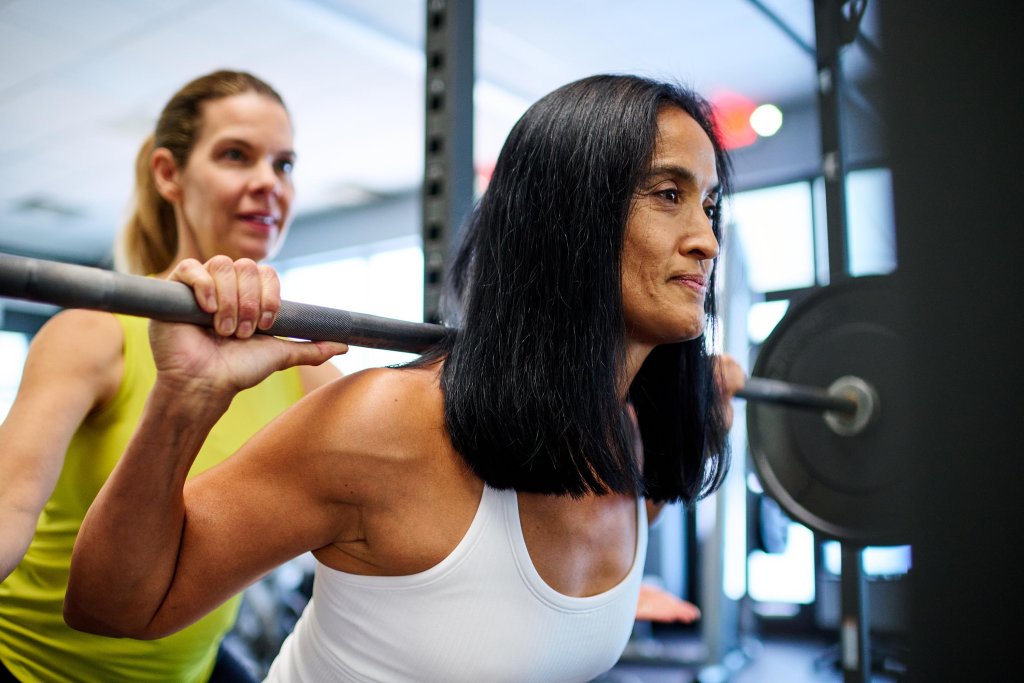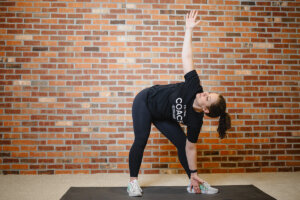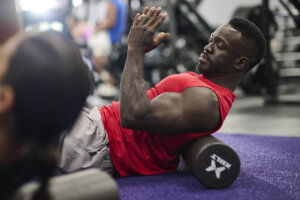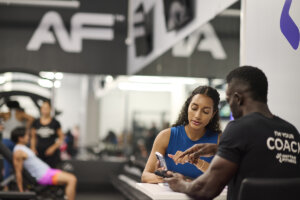Ready to crank up your strength-training routine? Barbell squats are a great way to increase muscle mass and get stronger, on top of giving you a confidence boost. Not only does barbell squatting target multiple muscle groups and burn calories rapidly, but it has some other surprising benefits for your overall health.
We asked Coach Mike from Anytime Fitness Woodbury, MN, to break down this classic exercise so you can get to squatting with confidence. Let’s find out how barbell squats can change not just your physical shape, but bring balance to other areas of your life as well.
What is a barbell squat, exactly?
Barbell squats are powerful exercises that can improve your overall strength. Essentially, the barbell back squat involves holding a barbell that rests on your shoulders while lowering your body down toward the ground by bending at the knees and hips.
How barbell squats can improve your health
This compound movement engages numerous muscle groups, including your quads, glutes, hamstrings, and even your core. “Squats are a great exercise for strengthening the lower body,” says Coach Mike. Plus, the added weight of the barbell helps you build strength in your back muscles and increase your endurance to take on even more challenging exercises.
Improved core and lower body strength can improve your life outside the gym. While you’ll likely not replicate the exact movement in your day-to-day life, training these muscle groups will help improve your ability to perform everyday tasks activities. A stronger core means better posture, and the increased muscle mass in your legs and glutes can help boost your metabolism and aid in weight loss. And let’s not forget about the cardiovascular benefits of this exercise — it gets your heart rate up and burns calories.
Barbell squats can be a big confidence booster as well. Challenging yourself to lift heavier weights and master a new-to-you workout can result in a tremendous sense of pride. This feeling of accomplishment can help boost your confidence both in and out of the gym.
Beginner basics for learning the barbell squat
Leveraging this powerful weightlifting exercise not only helps strengthen muscles and joints but also aids improved balance and coordination over time. But before we jump to the benefits, let’s take a look at the building blocks.
Are barbell squats good for beginners?
If you’re a beginner to squats or strength training in general, Coach Mike recommends you don’t jump immediately into the barbell back squat. “First, work on mastering the squat movement pattern,” he says.
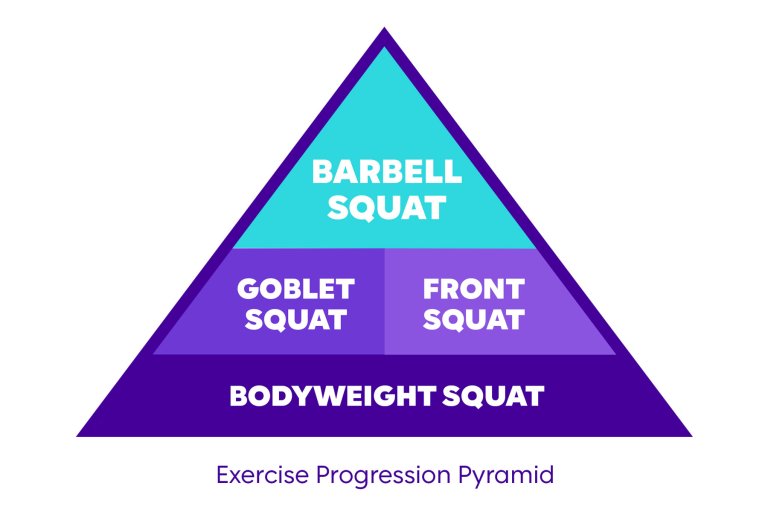
“I like to look at the progression to the barbell back squat as a pyramid,” Coach Mike says. “First, one should master bodyweight squats, followed by a goblet squat, the front squat, and then at the top of the pyramid the barbell back squat.”
How should I warm up for a barbell squat?
You should never go into a barbell squat cold! To warm up, Coach Mike recommends following this routine before moving on to weighted squats:
- Foam roll your quads
- Stretch your hip flexor muscles
- Do one set of corrective or core exercises (Bird Dog Planks, Side Plank Hip Thrust, Deadbugs, etc.)
- Practice the movement pattern with Bodyweight Squats
- Do one round of an explosive exercise, such as Jump Squats or Box Jumps
How much weight should a beginner barbell squat use?
When it comes to weight, everyone is different. “There is no set number for a beginner to barbell squat,” explains Coach Mike, “ I recommend starting with just the bar, and if you can perform your desired reps with good form, then you can add more weight from there.” For reference, a typical barbell weighs 45 lbs. before weight is added, with lighter bars weighing as little as 35 lbs.
How long should a beginner hold a squat?
Holding steady at the lowest part of the move requires focus and proper barbell squatting form. If you are just starting out, you’ll need to work your way up to longer hold times. With squats, the goal is never speed — carry your body slowly and carefully through the movement.
When it comes to holding a squat, Coach Mike recommends following these guidelines:
- Beginner: 10–20 seconds
- Intermediate: 30–40 seconds
- Advanced: 60+ seconds
What’s a good starting routine for beginners?
To incorporate barbell squats into a full workout, Coach Mike recommends a mix of other lower body moves. When following this low body strength routine, you should aim to perform about 3 sets of 6–8 reps each:
- Barbell Back Squat (or other variation of squats until ready to perform the barbell back squat)
- Leg Press Machine
- Step-ups
- Leg Extension Machine
- Leg Curl Machine
How to do a barbell squat
After you’ve mastered other variations of the squat — as seen in Coach Mike’s pyramid — you are now ready for the barbell back squat! IMPORTANT: if you feel like holding your breath through this move — don’t! You want to inhale before the squat and exhale as you press up from the bottom of the squat. So take a breath and let’s go through it step by step
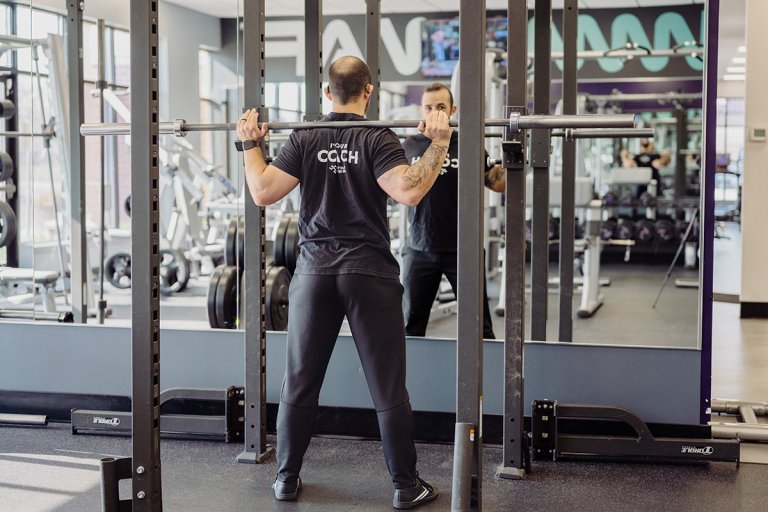
Step 1
Set the barbell rack to about the same height as your collarbone. Facing the bar, step under it, and put your arms around it to either side of you. Make sure the bar is not on your neck, but rather, sitting on top of your shoulders (aka trap muscles).
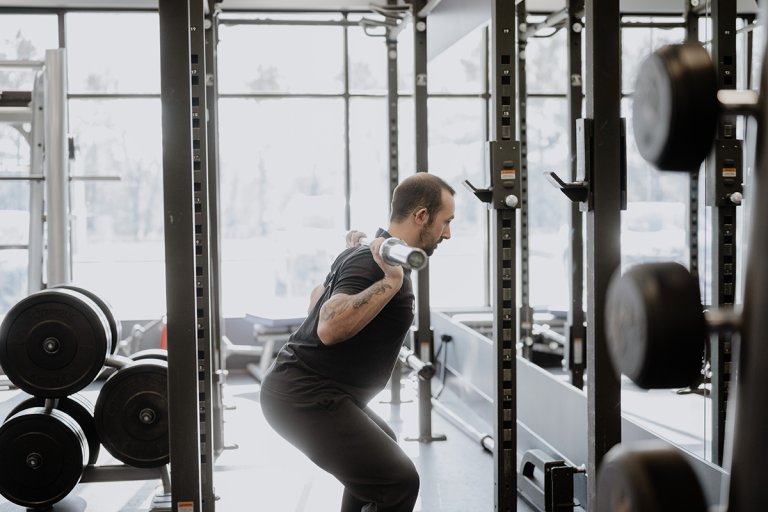
Step 2
Take a small step back, with your feet slightly wider than hip-width apart, your toes facing slightly outward. Flex your core, squeeze your glutes, and take a deep breath. Think about pushing your hips down and back, like you’re sitting down in a chair.
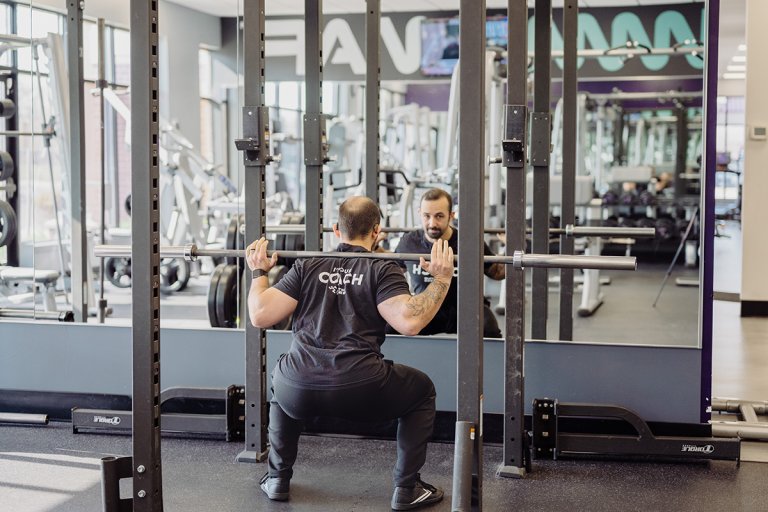
Step 3
Keep going until your legs are about parallel to your hips. Once you’ve hit the bottom of the squat, take a deep breath and explode back up to the starting position.
How to know if you’re squatting correctly
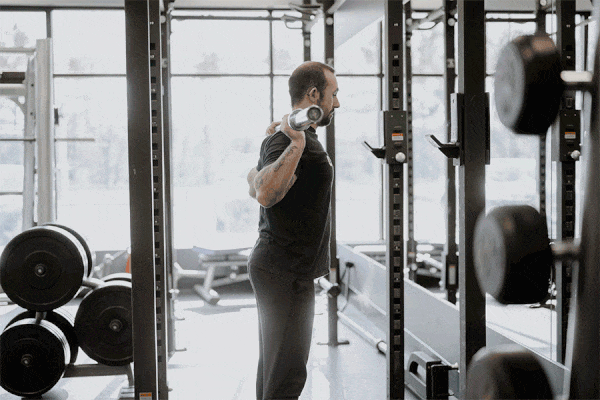
Building good form early on in your squat journey will help you be a better, safer, and stronger squatter in the long run. To practice good squatting form, your back should remain straight, with no flexion in the spine. You should also keep your head in a neutral position, looking forward or slightly upward.
Is it okay to lean forward while squatting?
According to Coach Mike, the answer is a resounding yes! “Depending on your own individual biomechanics, it is totally okay to have a slight forward lean while squatting, so long as there is no spinal flexion and the forward lean is not excessive.”
Is it okay to not squat all the way as a beginner?
You never want to push yourself past the point of exhaustion, especially when carrying a heavy bar on your shoulders. “As a beginner, it’s okay not to squat all the way to the ground,” Coach Mike says. “Try to squat as low as your body will comfortably go, with the goal of the tops of your legs reaching parallel to the ground.”
If you feel that you can’t squat properly, you may need to lower the amount of weight you’re using. If you’re only using a bar and still struggling, go back to bodyweight squats, goblet squats, or other lower-body moves to build your strength up before trying again.
How long does it take to see results from squatting?
The rate at which you’ll see results varies from person to person, but generally speaking it takes 3 to 4 weeks to see changes start to occur, with significant results becoming visible in as long as 12 weeks. The speed at which you see results hinges on a lot of factors from your diet to how consistently you strength train. Stick with it and know that real change takes time.
If you’re still struggling with doing a barbell squat as a beginner, you could benefit from working with a Coach! To get connected with an expert like Coach Mike, reach out to your local AF gym, or schedule a consultation through the AF App.

Coach Mike
Coach Mike found his passion for helping people working as a Coach at Anytime Fitness five years ago. Since then, he’s guided hundreds of people toward their fitness goals. Mike’s coaching philosophy resonates on and off the purple turf as he strives to help you become a stronger and more fulfilled version of yourself.
